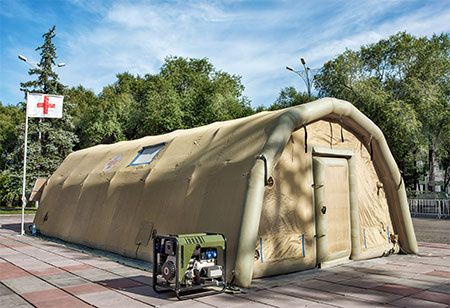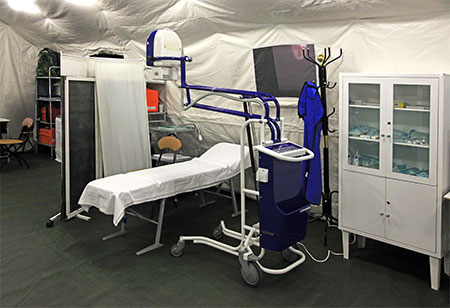
Mobile medical shelters are portable units that provide medical services in disaster zones. They support emergency responses where traditional health- care facilities are inaccessible or incapacitated. Their primary function is to offer a secure, sterile environment for medical teams to perform assess- ments, surgeries, and ongoing care.
These shelters vary in type, each designed for specific scenarios. Tents are commonly used for their quick deployment capabilities. Trailers provide a more robust structure, suitable for longer-term use and harsher conditions. Modular units can be configured to expand capacity and services, accommo- dating more complex medical needs. Each type is equipped to meet different challenges, ensuring flexible and efficient medical care delivery in critical times.
This article explores the need for these facilities during emergencies.
Deploying mobile medical shelters requires careful planning and coordination. Teams must transport these units quickly to the disaster sites. They use trucks, helicopters, or even boats, depending on the location's accessibility. Setup is equally vital, with a focus on speed and efficiency to ensure that medical services become available without delay.
For example, after earthquakes and wildfires, mobile medical shelters are often instrumental in providing immediate relief. These units are airlifted and set up within hours, offering critical surgical and first aid care to the injured and psychological support.
Mobile medical shelters are stocked with essential medical equipment to ensure comprehensive care. They typically include portable X-ray machines, ultrasound devices, and emergency surgical kits. A folding hospital bed is also necessary for providing proper patient care and comfort during treatment and recovery. These shelters also hold a stock of medications, bandages, and tools for trauma response.
Staffing these shelters requires a diverse team of healthcare professionals. Doctors, nurses, and specialists such as surgeons and anesthesiologists are crucial. They’re supported by lab technicians and pharmacists who manage the critical aspects of patient care. The staff works in shifts to maintain 24-hour operations, adapting to the urgent needs of disaster-affected populations.
This combination of well-chosen equipment and skilled personnel ensures that mobile medical shelters can provide high-quality medical care under challenging conditions.
One of the key advantages of mobile medical shelters is their flexibility and rapid deployment capabilities. These shelters can be transported and set up quickly in response to disasters, ensuring that medical care reaches affected areas without significant delays. This rapid deployment is crucial for saving lives and stabilizing critical patients immediately after a disaster strikes.
Furthermore, these shelters allow for the provision of specialized medical services directly at the disaster site. They can be equipped with advanced medical technology and staffed by specialists to handle a variety of medical issues, from trauma care to infectious disease control. This capability is vital in situations where local healthcare facilities are damaged or overwhelmed.
Thus, mobile medical shelters provide essential support in disaster zones, combining speed, flexibility, and specialized care to effectively address the immediate health needs of disaster-stricken communities.
 4. Challenges And Limitations Of Mobile Medical Shelters
4. Challenges And Limitations Of Mobile Medical SheltersDespite their numerous benefits, mobile medical shelters face several challen- ges. One significant drawback is their vulnerability in severe weather conditions. High winds, heavy rain, or extreme temperatures can hinder their deployment and functionality, affecting the safety and comfort of both patients and medical staff.
Additionally, logistical challenges often arise in remote or inaccessible areas. Transporting the necessary equipment and personnel to these locations can be complex and time-consuming, potentially delaying critical medical interven- tions.
Long-term sustainability and integration with local healthcare systems also pose issues. Mobile medical shelters are primarily designed for temporary relief, which can lead to challenges in providing continuous care or integrating smoothly with local healthcare provisions once the immediate crisis subsides.
Addressing these challenges is crucial for maximizing the effectiveness of mobile medical shelters in disaster response efforts.
Mobile medical shelters are indispensable in enhancing disaster response and recovery. They efficiently bridge the gap in emergency medical care when traditional healthcare facilities are overwhelmed or inoperable. These units provide critical medical services directly at the disaster sites, proving essential in saving lives and stabilizing affected communities.
To further enhance their efficiency and effectiveness, advancements in technology should be pursued. Innovations in shelter materials, telemedicine, and logistics can greatly improve the functionality of these shelters. Additionally, integrating these mobile units into national disaster management plans and emphasizing pre-deployment readiness would ensure faster and more coordinated responses.
It's also vital to implement training programs for disaster response teams, focusing on the deployment and management of mobile medical shelters. These programs would prepare teams to act swiftly and effectively, maximizing the potential of mobile medical units in future disasters.
We use cookies to ensure you get the best experience on our website. Read more...